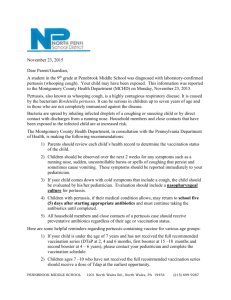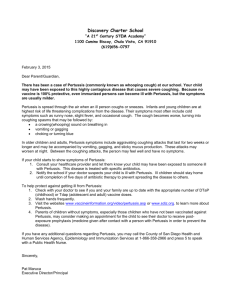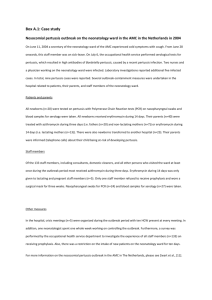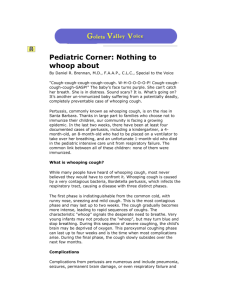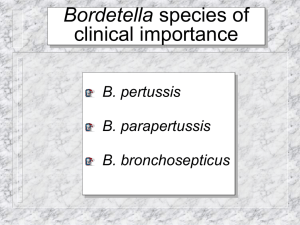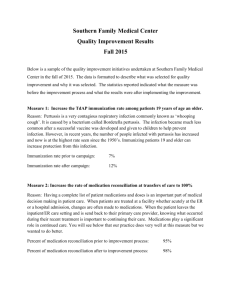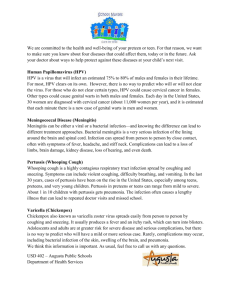Volume 24 - No 20: Bordetella
advertisement
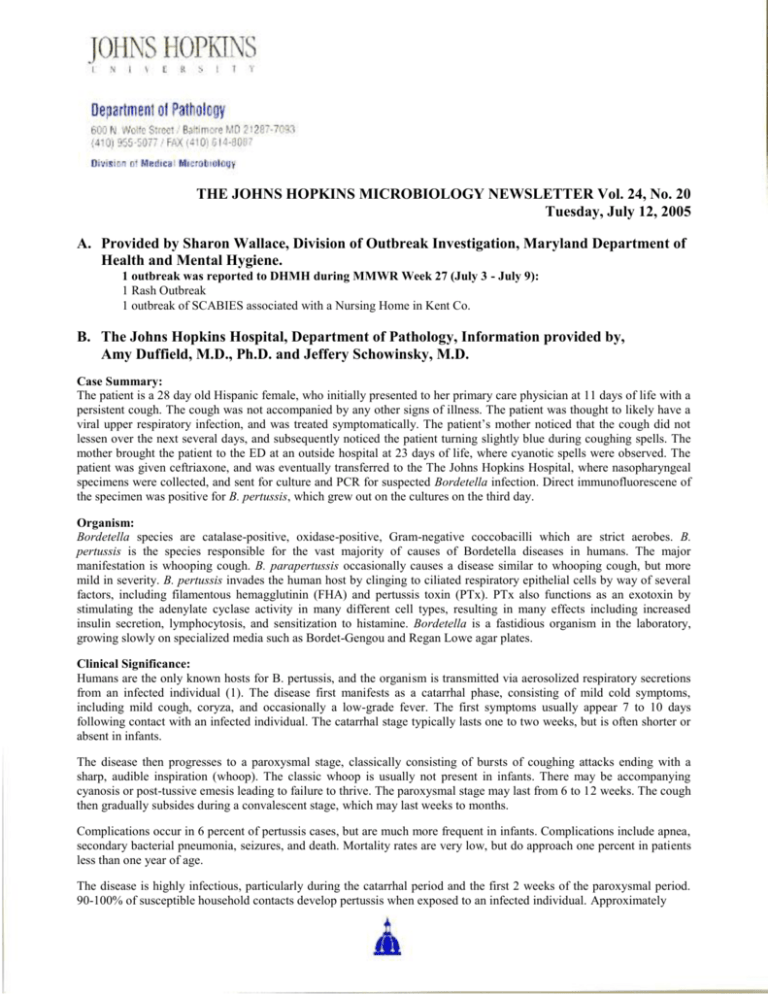
THE JOHNS HOPKINS MICROBIOLOGY NEWSLETTER Vol. 24, No. 20 Tuesday, July 12, 2005 A. Provided by Sharon Wallace, Division of Outbreak Investigation, Maryland Department of Health and Mental Hygiene. 1 outbreak was reported to DHMH during MMWR Week 27 (July 3 - July 9): 1 Rash Outbreak 1 outbreak of SCABIES associated with a Nursing Home in Kent Co. B. The Johns Hopkins Hospital, Department of Pathology, Information provided by, Amy Duffield, M.D., Ph.D. and Jeffery Schowinsky, M.D. Case Summary: The patient is a 28 day old Hispanic female, who initially presented to her primary care physician at 11 days of life with a persistent cough. The cough was not accompanied by any other signs of illness. The patient was thought to likely have a viral upper respiratory infection, and was treated symptomatically. The patient’s mother noticed that the cough did not lessen over the next several days, and subsequently noticed the patient turning slightly blue during coughing spells. The mother brought the patient to the ED at an outside hospital at 23 days of life, where cyanotic spells were observed. The patient was given ceftriaxone, and was eventually transferred to the The Johns Hopkins Hospital, where nasopharyngeal specimens were collected, and sent for culture and PCR for suspected Bordetella infection. Direct immunofluorescene of the specimen was positive for B. pertussis, which grew out on the cultures on the third day. Organism: Bordetella species are catalase-positive, oxidase-positive, Gram-negative coccobacilli which are strict aerobes. B. pertussis is the species responsible for the vast majority of causes of Bordetella diseases in humans. The major manifestation is whooping cough. B. parapertussis occasionally causes a disease similar to whooping cough, but more mild in severity. B. pertussis invades the human host by clinging to ciliated respiratory epithelial cells by way of several factors, including filamentous hemagglutinin (FHA) and pertussis toxin (PTx). PTx also functions as an exotoxin by stimulating the adenylate cyclase activity in many different cell types, resulting in many effects including increased insulin secretion, lymphocytosis, and sensitization to histamine. Bordetella is a fastidious organism in the laboratory, growing slowly on specialized media such as Bordet-Gengou and Regan Lowe agar plates. Clinical Significance: Humans are the only known hosts for B. pertussis, and the organism is transmitted via aerosolized respiratory secretions from an infected individual (1). The disease first manifests as a catarrhal phase, consisting of mild cold symptoms, including mild cough, coryza, and occasionally a low-grade fever. The first symptoms usually appear 7 to 10 days following contact with an infected individual. The catarrhal stage typically lasts one to two weeks, but is often shorter or absent in infants. The disease then progresses to a paroxysmal stage, classically consisting of bursts of coughing attacks ending with a sharp, audible inspiration (whoop). The classic whoop is usually not present in infants. There may be accompanying cyanosis or post-tussive emesis leading to failure to thrive. The paroxysmal stage may last from 6 to 12 weeks. The cough then gradually subsides during a convalescent stage, which may last weeks to months. Complications occur in 6 percent of pertussis cases, but are much more frequent in infants. Complications include apnea, secondary bacterial pneumonia, seizures, and death. Mortality rates are very low, but do approach one percent in patients less than one year of age. The disease is highly infectious, particularly during the catarrhal period and the first 2 weeks of the paroxysmal period. 90-100% of susceptible household contacts develop pertussis when exposed to an infected individual. Approximately 25% of infections are asymptomatic or atypical, and asymptomatic individuals are not believed to transmit the organism (2). Infection or immunization results in immunity; however, this immunity wanes over time. Epidemiology: The incidence of pertussis in the United States has been increasing since the 1980’s. This rise may reflect a true increase in the number of infections, or it may be due to the use of new diagnostic procedures, a change in methods of epidemiologic data collection, or increased recognition and diagnosis of the disease (2, 3). The crude average annual incidence rate of pertussis was 2.7 per 100,000 from 1997-2000, although atypical and mild cases of pertussis are significantly underdiagnosed, making the true incidence higher than the reported figures (2, 3). During this time, the average annual incidence rate of pertussis was highest among infants less than one year of age (55.5 cases per 100,000), with this rate falling to less than 5.5 cases per 100,000 in individuals greater than one year of age. In the United States, cyclic increases are seen every 3-4 years, and most cases occur between July and October (3, 4). Laboratory Diagnosis: B. pertussis colonizes the ciliated epithelial cells in both the upper and lower respiratory tracts, and satisfactory specimen collection can be accomplished using either a nasopharyngeal swab or aspirate. Collection swabs should be calcium alginate or Dacron, and not cotton or rayon both of which contain fatty acids that are toxic to B. pertussis. Calcium alginate swabs should not be used when the specimen is being submitted for PCR. Acceptable transport media include modified Regan-Lowe medium or, less preferably, the non-nutritive Amies’ medium. Immediate culture of a specimen is ideal. B. pertussis may be successfully isolated on modified Regan-Lowe agar or fresh Bordet-Gengou agar with incubation at 35-36°C in high humidity, ambient air for up to 14 days. It can be identified using specific antiserum agglutination or immunofluorescence. Direct immunofluorescence assays can be used to probe nasopharyngeal secretions for B. pertussis without the need for amplification in culture. DFA is inexpensive, rapid and may provide a positive result when cultures are negative due to prior treatment of the patient with antibiotics. Rarely, positive DFA results may occur due to cross-reactions with normal nasopharyngeal flora, and DFA is somewhat insensitive because the sample is not amplified. PCR may also be used directly on nasopharyngeal secretions to detect B. pertussis. PCR is both rapid and sensitive, although care must be taken to avoid false positive results caused by inadvertent contamination of PCR reaction mixtures. In one study comparing B. pertussis sensitivity and specificity among culture, DFA and PCR, the following data were obtained: Culture sensitivity 15.2% and specificity 100%; DFA sensitivity 52.2% and specificity 98.2%; PCR sensitivity 93.5% and specificity 97.1%. This study did not include comparison with serologic diagnosis; thus, the reported sensitivity of these methods is likely to be artificially inflated (5). Serologic tests are not well-standardized and are not commonly used (4). Treatment: Antimicrobial therapy with erythromycin or azithromycin does not alter the clinical course of the illness, but it does eliminate B. pertussis from the nasopharynx and treated individuals are no longer infectious. There is no proven effective therapy for the cough. Post-exposure immunization with vaccine, administration of immunoglobulin, and prophylaxis with erythromycin are not effective in preventing clinical pertussis in exposed individuals, although erythromycin prophylaxis is still recommended for those with pertussis contacts. Given the recent increase in pertussis incidence, and the fact that adults who have lost immunity can serve as a reservoir of B. pertussis, routine DTaP (Diptheria, Tetanus, acellular Pertussis) immunzation, as opposed to DT immunization alone, is currently under consideration for adults (6). References: 1. T. Tan. 2005 Summary: Epidemiology of Pertussis Pediatr Infect Dis J 24:5, S35-S38. 2. Byrd, E and C Ohl. 2005 Pathogenesis and epidemiology of Bordetella pertussis infection Up to Date. http://www.utdol.com/application/topic.asp?file=bact_inf/32928&type=P&selectedTitle=12~15 3. Pertussis --- United States, 1997--2000 http://www.cdc.gov/mmwr/preview/mmwrhtml/mm5104a1.htm 4. McNeil, BK and H. Guito-Ocampo. 2004 Pertussis. http://www.emedicine.com/ped/topic1778.htm 5. Cherry, JD, Grimprei, E, Guiso, N, Heininger, U and J Mertsola. 2005 Defining Pertussis Epidemiology: Clinical, Microbiologic and Serologic Perspectives. Pediatr Infect Dis J. 24(5) pp. 25-34. 6. S. Yeh. 2005 Treatment and prevention of Bordetella pertussis infection in infants and children. Up to Date. http://www.utdol.com/application/topic.asp?file=pedi_id/21439&type=P&selectedTitle=11~15
